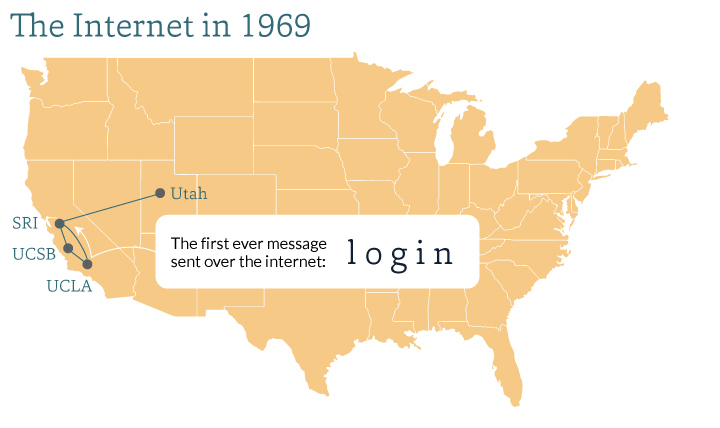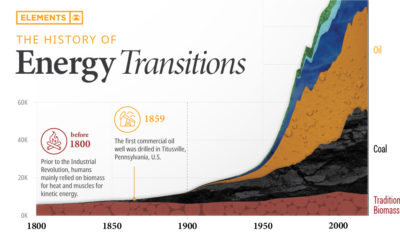At first, the system crashed, only managing to send the letters “i” and “o”. But an hour or so later, the full message was successfully sent and history was made:
Today, the internet permeates every facet of modern life. Billions of people around the world communicate through messaging apps, email, and social media platforms. By 2020, an estimated 20.8 billion “things” will be connected to the internet (including 13 billion household items like TVs, smoke detectors, and appliances).
It all starts somewhere
Though YouTube, Facebook, and email are ubiquitous now, they all started out with a single post, profile, or message, and that first action is not always what you’d expect. As today’s infographic from Academized demonstrates, “firsts” on the internet are typically unpolished, unique snapshots of the people involved in creating the platform. From elephants at the zoo to live-streaming a coffee pot, we hope you enjoy this trip down memory lane.
Links to Notable Internet Firsts
Everything posted to the web now lives in perpetuity. Here are some notable internet firsts that can still be viewed, replicated, or experienced: The First Search Engine The first search engine was created to connect the McGill University’s School of Computer Science to the Internet. The engine, called Archie, was up-and-running in 1990, a full eight years before Google was created. The University of Warsaw still hosts a functioning version of Archie for historical purposes. The First YouTube Video The very first YouTube video was uploaded by YouTube’s co-founder, Jawad Karim. The 19-second video is no Gangnam Style. Jawad, who is standing in front of an elephant enclosure, deadpans, “Uh. The cool thing about these guys is that, is that they have really, really, really long, um, trunks, and that’s, that’s cool.” Cool, indeed. The First Tweet
— jack (@jack) March 21, 2006 Internet firsts are rarely flashy, as this tweet from Twitter co-founder, Jack Dorsey, demonstrates. That said, as startups grow from rag-tag teams of determined founders into global behemoths, it’s nice to look back at those authentic, spontaneous first pieces of content.
on Even while political regimes across these countries have changed over time, they’ve largely followed a few different types of governance. Today, every country can ultimately be classified into just nine broad forms of government systems. This map by Truman Du uses information from Wikipedia to map the government systems that rule the world today.
Countries By Type of Government
It’s important to note that this map charts government systems according to each country’s legal framework. Many countries have constitutions stating their de jure or legally recognized system of government, but their de facto or realized form of governance may be quite different. Here is a list of the stated government system of UN member states and observers as of January 2023: Let’s take a closer look at some of these systems.
Monarchies
Brought back into the spotlight after the death of Queen Elizabeth II of England in September 2022, this form of government has a single ruler. They carry titles from king and queen to sultan or emperor, and their government systems can be further divided into three modern types: constitutional, semi-constitutional, and absolute. A constitutional monarchy sees the monarch act as head of state within the parameters of a constitution, giving them little to no real power. For example, King Charles III is the head of 15 Commonwealth nations including Canada and Australia. However, each has their own head of government. On the other hand, a semi-constitutional monarchy lets the monarch or ruling royal family retain substantial political powers, as is the case in Jordan and Morocco. However, their monarchs still rule the country according to a democratic constitution and in concert with other institutions. Finally, an absolute monarchy is most like the monarchies of old, where the ruler has full power over governance, with modern examples including Saudi Arabia and Vatican City.
Republics
Unlike monarchies, the people hold the power in a republic government system, directly electing representatives to form government. Again, there are multiple types of modern republic governments: presidential, semi-presidential, and parliamentary. The presidential republic could be considered a direct progression from monarchies. This system has a strong and independent chief executive with extensive powers when it comes to domestic affairs and foreign policy. An example of this is the United States, where the President is both the head of state and the head of government. In a semi-presidential republic, the president is the head of state and has some executive powers that are independent of the legislature. However, the prime minister (or chancellor or equivalent title) is the head of government, responsible to the legislature along with the cabinet. Russia is a classic example of this type of government. The last type of republic system is parliamentary. In this system, the president is a figurehead, while the head of government holds real power and is validated by and accountable to the parliament. This type of system can be seen in Germany, Italy, and India and is akin to constitutional monarchies. It’s also important to point out that some parliamentary republic systems operate slightly differently. For example in South Africa, the president is both the head of state and government, but is elected directly by the legislature. This leaves them (and their ministries) potentially subject to parliamentary confidence.
One-Party State
Many of the systems above involve multiple political parties vying to rule and govern their respective countries. In a one-party state, also called a single-party state or single-party system, only one political party has the right to form government. All other political parties are either outlawed or only allowed limited participation in elections. In this system, a country’s head of state and head of government can be executive or ceremonial but political power is constitutionally linked to a single political movement. China is the most well-known example of this government system, with the General Secretary of the Communist Party of China ruling as the de facto leader since 1989.
Provisional
The final form of government is a provisional government formed as an interim or transitional government. In this system, an emergency governmental body is created to manage political transitions after the collapse of a government, or when a new state is formed. Often these evolve into fully constitutionalized systems, but sometimes they hold power for longer than expected. Some examples of countries that are considered provisional include Libya, Burkina Faso, and Chad.















